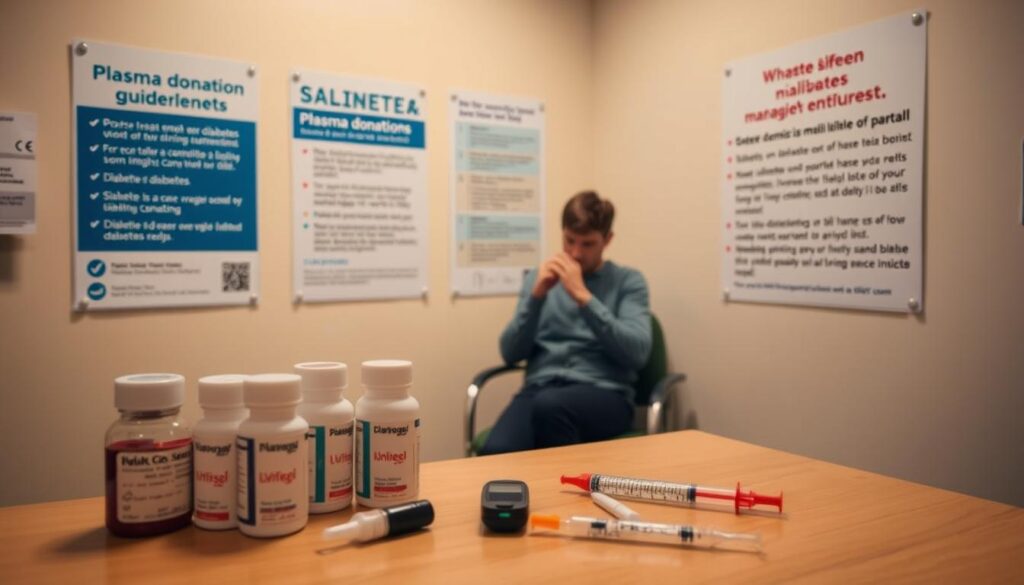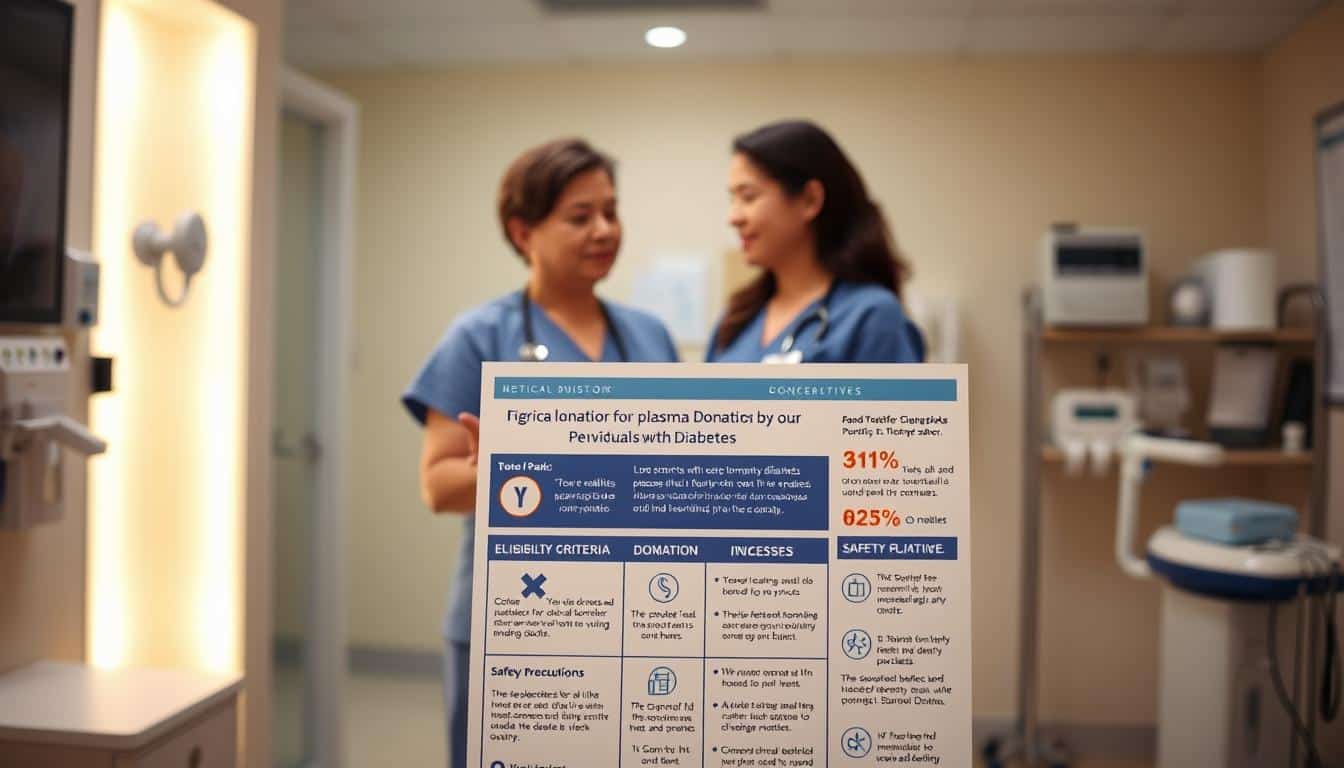Managing a chronic condition like diabetes involves many questions about daily activities, including medical procedures. Plasma donation is no exception. This article explores the guidelines and requirements for those interested in contributing to this life-saving process while managing their health effectively.
Research from trusted organizations like PlasmaSource and Virta Medical Affairs shows that eligibility often depends on specific health factors. Stable blood sugar levels, proper medication management, and overall wellness play critical roles in determining whether you can safely participate.
Type 1 and type 2 diabetes each have unique considerations. For example, individuals using insulin or other treatments must meet additional criteria before donating. Your medical history and recent lab results will also influence eligibility.
This guide covers everything from pre-donation preparation to post-procedure care. You’ll learn how to navigate common concerns, understand clinic protocols, and ensure your safety throughout the process. Let’s dive into the details to help you make an informed decision.
Understanding Diabetes and Plasma Donation
Navigating life with diabetes often involves evaluating how different medical procedures fit into your health management plan. Blood sugar regulation and insulin use directly influence eligibility for certain activities. Let’s explore how this condition interacts with donation protocols.
What Is Diabetes?
Diabetes occurs when the body struggles to convert food into energy efficiently. This happens due to insufficient insulin production or an inability to use it properly. Insulin, a hormone made by the pancreas, helps glucose enter cells for energy. Without it, sugar builds up in the bloodstream.
Types of Diabetes and Their Impact on Donation
Type 1 diabetes involves little to no insulin production, requiring daily insulin therapy. Type 2 diabetes relates to insulin resistance, often managed through lifestyle changes or oral medications. Both types require stable blood sugar levels for medical procedures like plasma contribution.
Prediabetes—a precursor to type 2—indicates higher-than-normal blood sugar. While reversible, it highlights the importance of early intervention. Clinics assess these factors alongside medication regimens to ensure donor safety and procedure compatibility.
Eligibility and Health Requirements for Plasma Donation
Understanding eligibility for medical procedures requires careful evaluation of your health status. Clinics prioritize safety for both donors and recipients, which means meeting specific benchmarks. Stability in your condition and proactive management are key factors in qualifying.
General Eligibility Criteria
Most centers require donors to weigh at least 110 pounds and maintain good physical wellness. Recent lab results showing stable hemoglobin A1C—below 7% for many facilities—are often mandatory. Medication consistency matters: changes to insulin doses or oral treatments within 48 hours may temporarily disqualify you.
Discuss your medical history with a provider before scheduling an appointment. Conditions like uncontrolled hypertension or recent infections could affect approval. Transparency ensures clinics tailor their protocols to your needs.
Maintaining Healthy Blood Sugar Levels
Consistent glucose monitoring is essential. Centers typically ask for readings between 70-180 mg/dL before allowing contribution. If you use insulin, timing your doses correctly helps avoid spikes or drops during the process.
Bring snacks and hydration to maintain energy. Post-donation tracking with a glucometer ensures swift recovery. Many individuals with well-managed insulin regimens successfully participate by following these steps.
Can Diabetics Donate Plasma?
Many assume having diabetes automatically disqualifies you from contributing to plasma programs. This isn’t true. With proper management of your condition, participation is often possible. Studies show over 60% of people with stable glucose levels meet eligibility criteria, including those using insulin.
Clinics prioritize safety by reviewing recent health changes and lab results. If your treatment plan shifted in the last month—like insulin dosage adjustments—you may need to wait. Consistent A1C readings below 7% and glucose levels between 70-180 mg/dL are typically required.
A common misunderstanding involves confusing donating blood with plasma. Plasma centers use different screening protocols, focusing on hydration and protein levels. Organizations like PlasmaSource confirm that well-managed diabetes rarely impacts this process when people follow pre-donation guidelines.
Always share accurate information about medications and health history during screening. Transparency ensures clinics tailor their approach to your needs. With careful preparation, contributing to plasma programs remains a viable option for many managing this condition.
Managing Diabetes Medications and Insulin Considerations
Proper medication management plays a vital role in preparing for plasma contribution. Your treatment regimen must align with clinic safety protocols to ensure a smooth experience. Stability in timing, dosage, and blood sugar tracking helps meet health benchmarks required by most facilities.

Medication Management With Diabetes
Insulin and oral medications work by regulating glucose levels in your bloodstream. Consistency is critical—sudden changes to your routine can affect eligibility. For example, altering insulin doses within 48 hours of the donation process may lead to temporary disqualification.
Clinics follow strict guidelines to confirm medications won’t interfere with your safety. They’ll review your prescription history and recent lab results. Share details about insulin types, injection schedules, or non-insulin therapies during screening.
During the procedure, staff monitor for signs of dizziness or fatigue linked to glucose fluctuations. Hydration and a protein-rich meal beforehand help maintain energy. Check your levels with a glucometer immediately after completing the donation.
To align your regimen with requirements:
- Consult your doctor about timing medications around appointments
- Avoid skipping or doubling doses without medical approval
- Keep a log of blood glucose readings for three days prior
Preparation and Safety Tips Before Donation
Proper preparation ensures your safety and maximizes the effectiveness of the process. Following expert guidelines helps maintain stable glucose levels while supporting your body’s needs. Let’s explore practical steps to prepare physically and mentally.
Pre-Donation Health Checks
Schedule a medical review with your doctor 1-2 weeks before your appointment. Discuss current medication dosages and any recent health changes. Clinics typically require proof of stable A1C levels from the past three months.
Bring documentation of recent lab results and insulin schedules. Facilities like PlasmaSource recommend checking blood pressure and iron levels 24 hours beforehand. Avoid caffeine or nicotine, as they can affect hydration and circulation.
Diet, Hydration, and Blood Sugar Strategy
Eat a balanced meal rich in lean protein and complex carbs 2-3 hours before the process. Virta Medical Affairs suggests options like grilled chicken with quinoa and steamed vegetables. Drink 16-20 ounces of water 90 minutes prior to support plasma volume.
Test your glucose levels upon waking and again before leaving home. Keep fast-acting snacks like nuts or fruit nearby in case levels drop. Individuals using insulin should time injections to avoid peaks during donation hours.
Post-appointment, rehydrate with electrolyte-rich fluids and monitor your body’s response. Most centers advise waiting 48 hours before resuming intense physical activity. These steps help thousands of individuals contribute safely each year.
The Donation Process: What to Expect
Understanding the steps involved in plasma contribution helps demystify the procedure and builds confidence. Clinics follow strict protocols to prioritize safety while collecting this vital resource. Let’s break down how modern facilities manage this process efficiently.

Step-by-Step Overview
The process begins with registration and a health screening. Staff review your medical history and check vital signs like blood pressure and pulse. They’ll also test hemoglobin levels and confirm your blood sugar levels fall within safe ranges.
Next, you’ll move to a donation chair. A sterile needle draws blood into an automated machine that separates plasma from other components. This takes 60-90 minutes, depending on hydration and protein intake. Red blood cells and platelets return to your body through the same line.
Throughout the session, trained professionals monitor for dizziness or fatigue. They may pause the procedure if your glucose readings shift unexpectedly. Facilities like PlasmaSource use real-time tracking systems to ensure control over every phase.
After completion, staff apply a bandage and provide recovery instructions. You’ll receive fluids and snacks to stabilize energy levels. Most centers recommend waiting 48 hours before intense physical activity to support full recovery.
Following pre-donation requirements—like maintaining a balanced diet and hydration—optimizes outcomes. Those with chronic disease management plans should inform staff about medications or recent health changes. This transparency ensures personalized care aligned with your needs.
Potential Risks and Post-Donation Care
Contributing to plasma programs involves balancing potential risks with proper aftercare strategies. Temporary changes in blood glucose levels rank among the most common concerns, though these are manageable with careful monitoring. Let’s explore how to address short-term effects while prioritizing recovery.
Recognizing and Managing Risks
Common short-term effects include lightheadedness or fatigue due to fluid loss. Research shows 1 in 5 individuals experience a mild drop in sugar levels within the first hour. Those managing type 1 diabetes or type 2 diabetes should stay alert for sweating, shakiness, or confusion.
Clinics often provide glucose tablets or juice to stabilize levels quickly. Inform staff immediately if symptoms arise. Avoid driving until you confirm stable readings through a fingerstick test.
Post-Donation Monitoring and Recovery
After donating, check your blood glucose levels immediately using a glucometer. Virta Medical Affairs recommends repeating tests every 30 minutes for two hours. Hydrate with water or electrolyte drinks to replenish plasma volume.
Rest for 24-48 hours and avoid strenuous activities. Consume protein-rich snacks like nuts or yogurt to support energy restoration. Facilities screen all contributors to ensure they’re eligible to donate blood products safely, but personal vigilance remains key.
Share your donation schedule with healthcare providers. They can adjust medication timing or suggest recovery tweaks tailored to your type of diabetes. With proper precautions, studies confirm over 90% of participants resume normal activities within a day.
Health Provider Insights and Expert Recommendations
Seeking professional guidance ensures your health priorities align with plasma contribution goals. Organizations like PlasmaSource and Virta Medical Affairs emphasize that medical oversight transforms general guidelines into safe, personalized plans. This collaboration helps address unique challenges while supporting community health initiatives.
Consulting Your Doctor About Plasma Donation
Before scheduling a blood plasma appointment, consult your healthcare provider. Endocrinologists review your medication schedule, recent A1C results, and overall stability. They determine if donating plasma fits safely into your management strategy.
Experts recommend discussing how blood donation protocols might affect glucose levels. For example, slight dehydration during the process could temporarily elevate readings. Your doctor may suggest adjusting insulin timing or increasing hydration 24 hours beforehand.
Share details about any recent health changes, like infections or new prescriptions. Facilities often require medical clearance if your treatment plan shifted within the past month. Transparency helps providers create safeguards tailored to your needs.
Virta Medical Affairs advises tracking blood sugar levels more frequently for 48 hours post-donation. Carry fast-acting carbohydrates and inform clinic staff if you feel lightheaded. Studies show people diabetes who follow these steps report fewer complications.
Regular communication with your care team ensures ongoing eligibility. Update them after each donation to refine your approach. With expert support, contributing to blood plasma programs becomes a sustainable part of your health journey.
Conclusion
Living with diabetes requires consistent health management, but it doesn’t exclude you from meaningful acts like plasma contribution. This guide outlined how maintaining stable glucose levels, understanding eligibility requirements, and coordinating with healthcare providers create a path to safe participation.
If you’re feeling well and your condition remains controlled, medical organizations confirm this process aligns with responsible health practices. Key steps include reviewing medication plans, tracking lab results, and prioritizing hydration before appointments.
Always consult your care team to verify readiness. Share your donation goals and recent health updates for personalized advice. Those meeting clinic benchmarks often find this act strengthens their sense of purpose while supporting community needs.
Use the strategies discussed—from pre-donation preparation to post-procedure monitoring—to make informed choices. When managed thoughtfully, contributing plasma becomes both a safe endeavor and a powerful way to help others. Consider exploring local centers if you meet the eligibility requirements and maintain consistent glucose levels.
Your journey with diabetes can include opportunities to give back. With proper planning and medical guidance, you’re empowered to make decisions that benefit your wellness and those in need.
FAQ
Are individuals with diabetes allowed to give plasma?
Yes, in most cases. Eligibility depends on well-managed blood sugar levels, stable health, and meeting general donor criteria. Organizations like the American Red Cross or FDA-approved centers set specific guidelines.
How do insulin injections affect eligibility?
Using insulin doesn’t automatically disqualify you. Donors must have consistent glucose control and no recent dosage changes. Share your treatment plan with the center for approval.
What blood sugar range is required for donation?
Centers typically require fasting glucose between 80-180 mg/dL. Levels outside this range may delay your appointment. Check your numbers before arriving.
Should medications like metformin be paused before donating?
Never adjust prescriptions without consulting your doctor. Most oral diabetes drugs don’t interfere, but disclose all medications during screening.
How can you prepare your body for the procedure?
Stay hydrated, eat iron-rich meals, and avoid high-sugar foods 24 hours prior. Monitor glucose closely and bring snacks to stabilize levels post-donation.
Are there heightened risks for donors with this condition?
Risks like dizziness or fatigue are similar to others but may occur more frequently if glucose drops. Staff will monitor you and provide recovery support.
Why is a doctor’s note recommended before donating?
A healthcare provider can confirm your stability and address concerns like circulation issues or neuropathy. This ensures safer participation.
What post-donation steps help maintain stable health?
Rest, hydrate, and test glucose regularly. Report symptoms like nausea or blurred vision immediately. Avoid strenuous activity for 12-24 hours.


